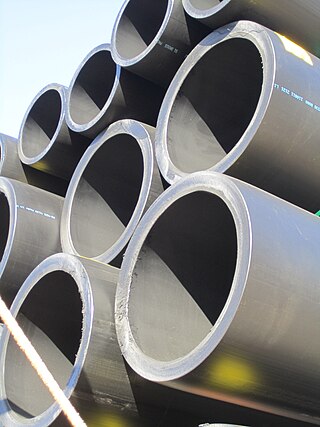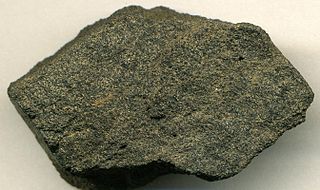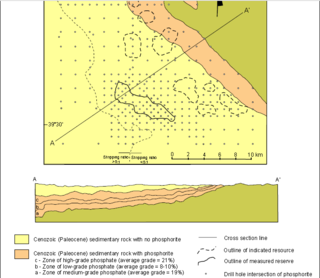
A slurry pipeline is a specially engineered pipeline used to move ores, such as coal or iron, or mining waste, called tailings, over long distances. A mixture of the ore concentrate and water, called slurry, is pumped to its destination and the water is filtered out. Due to the abrasive properties of slurry, the pipelines can be lined with high-density polyethylene (HDPE), or manufactured completely from HDPE Pipe, although this requires a very thick pipe wall. Slurry pipelines are used as an alternative to railroad transportation when mines are located in remote, inaccessible areas.

Phosphorite, phosphate rock or rock phosphate is a non-detrital sedimentary rock that contains high amounts of phosphate minerals. The phosphate content of phosphorite (or grade of phosphate rock) varies greatly, from 4% to 20% phosphorus pentoxide (P2O5). Marketed phosphate rock is enriched ("beneficiated") to at least 28%, often more than 30% P2O5. This occurs through washing, screening, de-liming, magnetic separation or flotation. By comparison, the average phosphorus content of sedimentary rocks is less than 0.2%.

Froth flotation is a process for selectively separating hydrophobic materials from hydrophilic. This is used in mineral processing, paper recycling and waste-water treatment industries. Historically this was first used in the mining industry, where it was one of the great enabling technologies of the 20th century. It has been described as "the single most important operation used for the recovery and upgrading of sulfide ores". The development of froth flotation has improved the recovery of valuable minerals, such as copper- and lead-bearing minerals. Along with mechanized mining, it has allowed the economic recovery of valuable metals from much lower-grade ore than previously possible.

Mineral processing is the process of separating commercially valuable minerals from their ores in the field of extractive metallurgy. Depending on the processes used in each instance, it is often referred to as ore dressing or ore milling.

The Sullivan Mine is a now-closed conventional–mechanized underground mine located in Kimberley, British Columbia, Canada. The ore body is a complex, sediment-hosted, sedimentary exhalative deposit consisting primarily of zinc, lead, and iron sulphides. Lead, zinc, silver and tin were the economic metals produced. The deposit lies within the lower part of the Purcell Supergroup and mineralization occurred about 1470 million years ago during the late Precambrian (Mesoproterozoic).

Kirandul is a town and a municipality in Dantewada district in the Indian state of Chhattisgarh. It is located roughly 400 km south of Raipur, capital of Chhattisgarh and 41 km southwest of Dantewada-the district headquarters. The way to travel is by road with frequent bus service from Raipur, Bhilai and Jagdalpur or by train from Jagdalpur and Visakhapatnam.It has the world's largest iron ore mine according to 2021 survey
The Red Dog mine is a large zinc and lead mine in a remote region of Alaska, about 80 miles (130 km) north of Kotzebue, which is operated by the Canadian mining company Teck Resources on land owned by the NANA Regional Corporation. It is located within the boundaries of the Red Dog Mine census-designated place in the Northwest Arctic Borough of the U.S. state of Alaska.

Hemerdon Mine, also known as Hemerdon Ball Mine, Hemerdon Bal Mine and (briefly) previously as Drakelands Mine is a tungsten and tin mine. It is located 11 km northeast of Plymouth, near Plympton, in Devon, England. It lies to the north of the villages of Sparkwell and Hemerdon, and adjacent to the large china clay pits near Lee Moor. The mine had been out of operation since 1944, except for the brief operation of a trial mine in the 1980s. Work started to re-open it in 2014, but it ceased activities in 2018. It hosts the fourth largest tin-tungsten deposit in the world.
Railway stations in the Republic of the Congo (Congo) include:
The mineral industry of Russia is one of the world's leading mineral industries and accounts for a large percentage of the Commonwealth of Independent States' production of a range of mineral products, including metals, industrial minerals, and mineral fuels. In 2005, Russia ranked among the leading world producers or was a significant producer of a vast range of mineral commodities, including aluminum, arsenic, cement, copper, magnesium compounds and metals, nitrogen, palladium, silicon, nickel and vanadium.

Jalamid(Arabic: حزم الجلاميد) is a town and crossroads in Saudi Arabia near the Iraqi border.

The Batu Hijau mine is an open pit copper-gold mine operated by PT. Amman Mineral Nusa Tenggara. The mine is the second largest copper-gold mine in Indonesia behind the Grasberg mine of PT. Freeport Indonesia. The mine is located 1,530 kilometres (950 mi) east of the Indonesian capital Jakarta on Sumbawa, an island in West Nusa Tenggara Province, more precisely in the southern part of West Sumbawa Regency. The mine is the result of a ten-year exploration and construction program based on a 1999 discovery of the porphyry copper deposit. Production began in 2000.
Mauritania's mineral sector was dominated by iron ore mining and beneficiation. Other mineral commodities produced in the country included cement, copper, gold, gypsum, petroleum, salt, and steel. The 'Ministère des Mines et de l’Industrie' was the Government agency responsible for enacting the Mining Code and for the coordination of all activities in the mining sector. The 'Direction des Mines et de la Géologie' was the entity responsible for promoting the mineral sector and for providing geologic and mining information to potential investors; the 'Direction des Hydrocarbures' was in charge of the development of the petroleum sector; and the 'Office Mauritanien des Recherches Géologiques' was the Government entity responsible for evaluating areas of mineral potential for exploration. The 'Société Nationale Industrielle et Minière (SNIM)' was responsible for iron ore production and benefciation.
The Monts Avima are a mountain range in the Republic of the Congo near Gabon border to the west, and the Cameroon border to the north. The highest peak is the Mt. Avima in a 40 km west to east oriented ridge with several other top points which exceed 900 m above sea level. These mounts have a significant deposit of iron ore and few small gold placer deposits. The mountain is covered by rain-forest. The forest is inhabited by a small local tribe of native people who live on from hunting and from alluvial gold mining. Between March and September 2009 it was an access road built from Cameroon border to Mt. Avima for a mining exploration program arriving to the top of the mountain. After the exploration program, the road was covered by the rain forest blocking the access by vehicles to the mountain. Due to the significant quantities and qualities of iron ore discovered, it is expected that mining activities will start in the future.
Rampura Agucha is a zinc and lead mine located on a massive sulfide deposit in the Bhilwara district of Rajasthan, India. Rampura Agucha is located 220 km (140 mi) from Jaipur. It is north of Bhilwara, and northwest of Shahpura. Rampura Agucha is 10 km (6.2 mi) southeast of Gulabpura on NH 79. The mine is owned by Hindustan Zinc Limited (HZL), and has the world's largest deposits of zinc and lead.
The Kamoto Mine is an underground copper and cobalt mine to the west of Musonoi in the former Katanga Province, Democratic Republic of the Congo. As of 2022, the site is the largest active cobalt mine in the world. The mine includes the Luilu metallurgical plant, which accepts ore from KOV mine and Mashamba East mine. The plant has polluted the Luilu River, and tailings also pollute the region with wind-blown dust. The Kolwezi Tailings Project is an attempt to recover additional metal from these tailings.

Oil and gas dominate the extraction industries of the Republic of the Congo, also referred to as Congo-Brazzaville. The petroleum industry accounted for 89% of the country’s exports in 2010. Among African crude oil producers in 2010, The Congo ranked seventh. Nearly all of the country's hydrocarbons were produced off-shore. The minerals sector is administered by the Department of Mines and Geology. Presently no major mining activities are underway, although there are some small-scale domestic operations. However, the country does have numerous large-scale undeveloped resources. The country has recently attracted a strong influx of international companies seeking to tap into the vast mineral wealth.

The Jameson Cell is a high-intensity froth flotation cell that was invented by Laureate Professor Graeme Jameson of the University of Newcastle (Australia) and developed in conjunction with Mount Isa Mines Limited.
The Uley graphite project is a graphite mine at Uley 23 km southwest of Port Lincoln on the Eyre Peninsula in South Australia. It is also known as the Ouray mine. The mine is under "care and maintenance".
The Finnis Lithium Project is a lithium mine situated near Darwin in the Northern Territory, Australia. It is being developed by Core Lithium.














